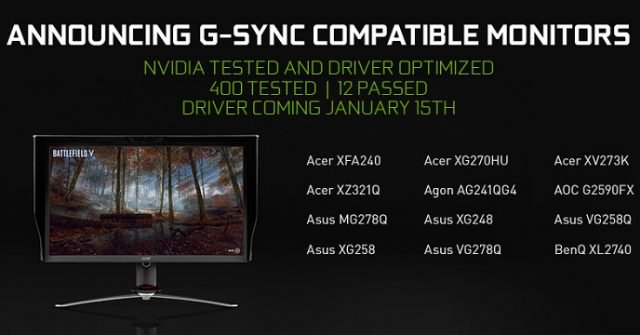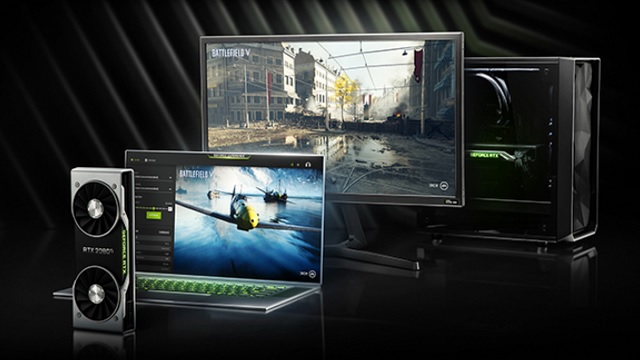The new Nvidia Freesync driver is available now, bringing variable refresh rate support on Nvidia cards to more monitors. Nvidia announced their new software support for variable refresh rate displays at CES 2019. Freesync-style software variable refresh rate can now be activated in the Nvidia Control Panel.
GeForce driver 417.71 was released on January 15, letting GeForce graphics cards use the adaptive sync capabilities of AMD Freesync-branded monitors. Before this update, GeForce GPUs were only able to sync refresh rates to Nvidia G-Sync displays, which were often more expensive than similar AMD Freesynch monitors. To activate adaptive sync on non-G-Sync monitors while using an Nvidia GPU you will have to dive into the Nvidia Control Panel.
Nvidia Freesync driver – G-Sync compatible displays make it easy
When Nvidia announced its new variable refresh rate driver, the company also a new “G-Sync Compatible” branding for certain displays. These displays were explicitly tested by the company to provide proper adaptive sync with the new Nvidia Freesync driver. Of the 400 monitors Nvidia tested, only 12 earned the certification.
The new Nvidia Freesync driver will automatically activate adaptive sync if any of those 12 displays are connected to your computer. The following 12 monitors have all received Nvidia’s testing, driver optimization, and OK.
- Acer XFA240
- Acer XG270HU
- Acer XV273K
- Acer XZ321Q
- AOC Agon AG241QG4
- AOC G2590FX
- Asus MG278Q
- Asus XG248
- Asus VG258Q
- Asus XG258
- Asus VG278Q
- BenQ XL2740

These aren’t the only monitors that will work with the new Nvidia Freesync driver, but they are the only ones that will work right out of the box.
Nvidia Freesync driver – the Nvidia Control Panel will show you the way
Setting up adaptive sync support using Nvidia’s new driver is easy and quick. When connected to a Freesync display, open the Nvidia Control Panel. To do this you can right-click on the Windows desktop and select it, or type it into your Windows search bar. In the Display section of the navigation pane select the “Set up G-Sync” menu. Within the menu, check the “enable G-Sync, G-Sync Compatible” box and select the proper display. Then check the “enable settings for the selected display model” box. Click “apply” in the bottom-right side of the page.
Nvidia has said that these options may not be available or work. To get it working, go to “manage 3D settings” and click the “global” tab. From there select “monitor technology” and select “G-Sync Compatible” in the drop-down menu, then apply the settings.
However, there are some drawbacks to the new Nvidia Freesync driver. For starters, Nvidia’s new software adaptive sync only works using DisplayPort, whereas AMD’s solution would also work via HDMI. The other caveat is that displays not certified by Nvidia may not work properly.
A crowdsourced Google spreadsheet (courtesy of the Nvidia subreddit) has started documenting which Freesync monitors are compatible with the new 417.71 driver. Most monitors appear to work just fine with the new Nvidia driver, although some users are finding external tools necessary to maintain proper results.
Nvidia Freesync driver – what GeForce GPUs support adaptive sync, and why it matters
Adaptive sync, variable refresh rate, Nvidia G-Sync, and AMD Freesync are all names or solutions built to match monitor refresh rates to the content coming from video cards. Without adaptive sync technology, a varied framerate would cause screen tearing on a standard display. This means that multiple frames would be shown on screen at a time, leading to the full image not matching. Adaptive sync alters the refresh rate of monitors to the frame rate of content, meaning that screen tearing is no longer a problem.
Nvidia G-Sync launched in 2014 alongside a range of G-Sync monitors. Nvidia’s proprietary adaptive sync technology relies upon special hardware in monitors, leading to higher cost of G-Sync monitors. Nvidia G-Sync is supported by most desktop GeForce GPUs starting with the GTX 600-series. Some laptop GPUs support G-Sync, although that support started with the GTX 900 range.
The new Nvidia adaptive sync driver has been long-awaited by the PC community, as Nvidia-approved G-Sync monitors were more expensive than competitors. G-Sync did not offer any particular advantage over AMD Freesync technology, and homebrew solutions were used to bypass Nvidia’s restrictions.







